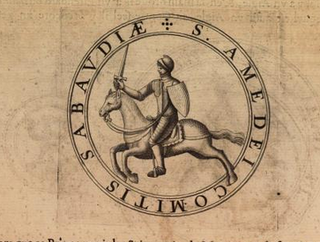
Amadeus IV was Count of Savoy from 1233 to 1253.
Peter II, called the Little Charlemagne, was Count of Savoy from 1263 until his death in 1268. He was also holder of the Honour of Richmond, Yorkshire, England, the Honour of the Eagle also known as the Honour of Pevensey and the Honour of Eu also known as the Honour of Hastings. His significant land holdings in Sussex were also marked by his holding of the wardship of John de Warenne, 6th Earl of Surrey which brought with it lands centred upon Lewes castle. Briefly, from 1241 until 1242, castellan of Dover Castle and Keeper of the Coast. In 1243 he was granted land by the Thames in London where he later built the Savoy Palace.

Amadeus V, also known as Amadeus the Great, was the Count of Savoy from 1285 until his death in 1323. He was a significant medieval ruler who played a crucial role in the expansion and consolidation of the House of Savoy’s influence in the regions that are now part of modern-day France, Italy, and Switzerland.

Aymon, Count of Savoy (1291–1343), also known as Aymon the Peaceful, was a nobleman who ruled the County of Savoy from 1329 until his death in 1343. He was a member of the House of Savoy, a prominent European noble family.

Amadeus VI, nicknamed the Green Count was Count of Savoy from 1343 to 1383. He was the eldest son of Aymon, Count of Savoy, and Yolande Palaeologina of Montferrat. Though he started under a regency, he showed himself to be a forceful leader, continuing Savoy's emergence as a power in Europe politically and militarily. He participated in a crusade against the Turks who were moving into Europe.
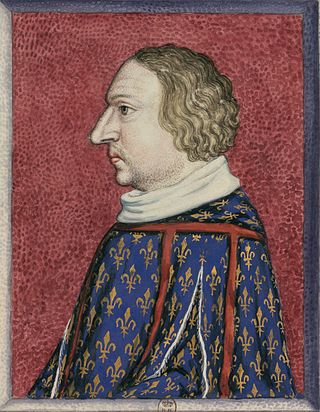
Louis I, Duke of Anjou was a French prince, the second son of John II of France and Bonne of Bohemia. His career was markedly unsuccessful. Born at the Château de Vincennes, Louis was the first of the Angevin branch of the Valois royal house. His father appointed him Count of Anjou and Count of Maine in 1356, and then raised him to the title Duke of Anjou in 1360 and Duke of Touraine in 1370.
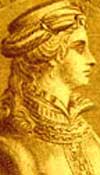
Bonne of Bourbon was a Countess of Savoy by marriage to Amadeus VI of Savoy. She served as regent of Savoy during the absence of her spouse from 1366 to 1367, with her son in 1383, and finally during the minority of her grandson Amadeus VIII, Duke of Savoy in 1391–1395.

The County of Geneva, largely corresponding to the later Genevois province, originated in the tenth century, in the Burgundian Kingdom of Arles (Arelat) which fell to the Holy Roman Empire in 1032.

Humbert II de la Tour-du-Pin was the Dauphin of the Viennois from 1333 to 16 July 1349. Humbert was the last dauphin before the title went to the French crown, to be bestowed on the heir apparent.
James was the Lord of Piedmont from 1334 to his death. He was the eldest son of Philip I and Catherine de la Tour du Pin. While his father had been stripped of the Principality of Achaea in 1307 by the Angevins of the Kingdom of Naples, James continued to use the princely title and even passed it on to his successors. However, James was not a son of Isabella Villehardouin - the first wife of his father - and thus not a descendant of the Villehardouin dynasty.
François de Candie was a savoyard nobleman named Vidame of Geneva from 1377 to 1385 and captain of the castle of l'Ile sur le Rhône in 1377. In 1368, he received from princess Mathide of Savoy the lordship on the castles of Salagine in Bloye and Rumilly, Haute-Savoie.

Amadeus III was the Count of Geneva from 1320 until his death. He ruled the Genevois, but not the city of Geneva proper, and it was during his time that the term "Genevois" came to be used as it is today. He was the eldest son and successor of William III and Agnes, daughter of Amadeus V of Savoy. He played a major rôle in the politics of the House of Savoy, serving consecutively as regent and president of the council, and also sitting on the feudal tribunal—one of three tribunals of the Audiences générales—of the Duchy of Aosta.
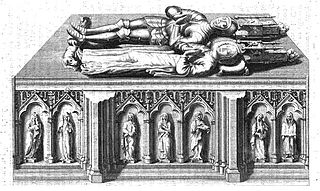
Yolande Palaiologina or Violant was the Countess consort of Savoy by marriage to Aimone, Count of Savoy. She was the daughter of Theodore I, Marquess of Montferrat, and Argentina Spinola (1303-1356), a Genoese lady, daughter of Opicino Spinola. She received the name Yolande from her paternal grandmother Irene of Montferrat.
Bianca of Savoy was Lady of Milan by marriage to Galeazzo II Visconti.
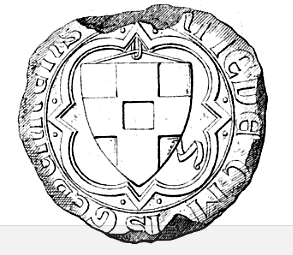
Amadeus II was the Count of Geneva, which included the Genevois, but not the city of Geneva, from 1280 to 1308. He was the second son of Count Rudolf and succeeded his heirless brother Aymon II.

The Barony of Vaud was an appanage of the County of Savoy, corresponding roughly to the modern Canton of Vaud in Switzerland. It was created by a process of acquisition on the part of a younger brother of the reigning count beginning in 1234 and culminated in the formalisation of its relationship to the county in 1286. It was semi-independent state, capable of entering into relations with its sovereign, the Holy Roman Emperor, and of fighting alongside the French in the Hundred Years' War. It ceased to exist when it was bought by the count in 1359. It was then integrated into the Savoyard state, where the title Baron of Vaud remained a subsidiary title of the heads of the family at least as late as the reign of Charles Albert of Sardinia, although the territory of the barony was annexed by the Canton of Bern during the Protestant Reformation (1536).

Louis II, son of Louis I of Vaud of the House of Savoy, was the Baron of Vaud from 1302 until his death. A military man, he fought widely in Italy and, during the first phase of the Hundred Years' War, in France. As a diplomat he visited England and the papal court in Rome and Avignon, and he served as regent of the County of Savoy between 1343 and his death, during which period he was the leader of the House of Savoy.

Louis I was the Baron of Vaud. At the time of his birth he was a younger son of the House of Savoy, but through a series of deaths and his own effective military service, he succeeded in creating a semi-independent principality in the pays de Vaud by 1286. He travelled widely in the highest circles of European nobility, obtained the right to mint coins from the Holy Roman Emperor, and convoked the first public assembly in the Piedmont to include members of the non-noble classes. When he died, his barony was inherited by his son.
Aymon III or Aimon III, a soldier, statesman and Crusader, was the twelfth Count of Geneva between January 1367 and his death seven months thence. He was the eldest son and successor of Amadeus III and Mahaut d'Auvergne. He pursued a policy of alliance and cooperation with the House of Savoy begun by his father. By all contemporary accounts, he was "handsome [and] possessed great charm of person and of manner."
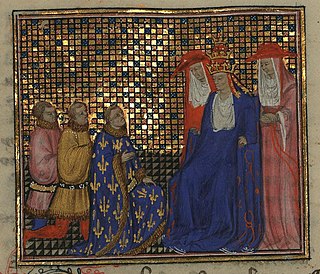
Robert of Geneva was elected to the papacy as Clement VII by the cardinals who opposed Pope Urban VI and was the first antipope residing in Avignon, France. His election led to the Western Schism.